
|   |

|   |
 e-mail: sunilkothari1933@gmail.com New York based Arts from India presented Navarasa online July 29, 2020 In present Corona virus times, there are few enterprisers who have been active assisting dancers to perform choosing a thematic content. Among them Ajayveer with help of Kathakali exponent Prabal Gupta and New York based celebrated dancer, curator, organizer, commentator, choreographer and well known for her Sutradhari Natyam, Rajika Puri as an anchor presented live concert of Navarasa recently. The timings were for USA - New York 9am till 11am and for India from 9pm till 11pm. However, with Q and A with Rajika Puri and dancers, the program extended by another 45 minutes and it ended at 11.45pm! There was admission fee and the audience had to buy tickets for viewing. 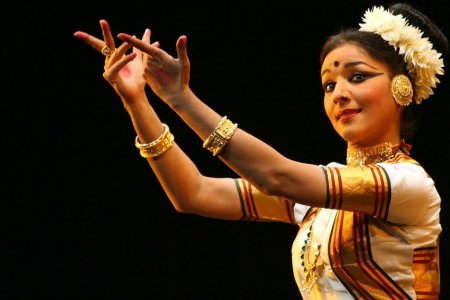 Vijayalakshmi The prime rasa Shringar was dealt by Mohiniattam dancer Vijayalakshmi, daughter / disciple of Bharati Shivaji. She chose from the Gita Govinda, ashtapadi Chandana charchita nila kalebara pita vasana vanamali, set to Sopanam music and choreographed by Bharati Shivaji. Credit goes to Bharati for introducing ashtapdis in Mohiniattam repertoire with Sopanam music. Vijayalakshmi's andolika, graceful and langorous movements highlighted the quintessential Mohiniattam characteristics. As a matter of fact, the nritta element with vaitaris, mnemonic syllables was rather overwhelming before coming to the rati bhava. Also it would have been interesting to see delineation of shringara, which was more in nature of description than in enhancing the sentiment. Krishna's playing raas, using various movements, clapping, circling, were choreographed well. In the end, the benediction that whoever listens to the praise of the deity would earn punya was enacted as ashtapadi ends there. In Q and A, it was interesting to learn that Vijayalakshmi after listening to Tchaikovsky's music for Swan Lake, choreographed Swan Lake theme in Mohiniattam and it was staged also at Bolshoi in Moscow and other cities where it had received great appreciation. 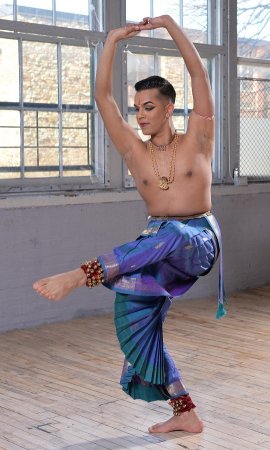 Kasi Aysola Hasya was presented by male Bharatanatyam exponent Kasi Aysola to two compositions of Dharmapuri Subbaraya Iyer. Kasi is a gifted dancer and what struck me most was his impersonation of female role without being effeminate. He brought out the female graces beautifully. He has studied Bharatanatyam under Viji Prakash and her daughter Mythili. The training is thorough and performance was most impressive. However, despite brief explanation by Rajika of the content of the composition, I was not able to notice the Hasya rasa. The song Entati kuluke was enjoyable, and was rendered melodiously. In the second song, what I could follow was Krishna's magic flute enchanting peacock and cows and gopis listening to flute leaving daily chores and rushing unto Krishna. I was not able to gauge Hasya rasa seeing these two compositions. I consider it entirely my limitation, as I could not comprehend them barring few movements. Rajika's questions regarding Kasi Aysola's interest in aharya et al were interesting but to me it did not add to the Rasa that was allotted to him. My comments are no reflection of Kasi's excellent dancing. 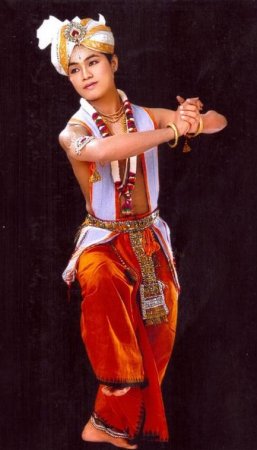 Sinam Basu Singh Sinam Basu Singh is a name to reckon with in Manipuri. A gifted dancer he has blossomed into a fine exponent and often performs with his wife, another gifted dancer. He chose Karuna rasa for depiction. One of his gurus Tiken Singh had set the music and choreography was by Amusana Devi. The typical Manipuri singing in high pitch and well known Tanchap tala were in traditional format. The elfin grace and petal soft graceful movements of Manipuri dance were in abundance. Impersonating gopi, though dressed in male costume, the feminine movements were captivating. Like Kavits in Kathak, the mukhbol in composition were noteworthy. The mnemonics for sound of ankle bells, jhan jhan, were executed beautifully. Pung vadan, the sound of the playing of mridang, Pung, evoked the Manipuri ambience. There were references of Krishna breaking pot and stealing butter; catching him while stealing, Gopi offers him butter; the shades of vatsalya, motherly love were indicated. The flow of Jamuna river, and Krishna's going away, one who as Gopala grazed the cows, gopi in the end prostrating and offering namsakar, highlighted the feeling of separation, resulting in Karuna rasa. In Q and A, Sinam explained the relevance of Tanchap tala and how in choreographing, it helps. He also mentioned how tisra and chatusra are being used. 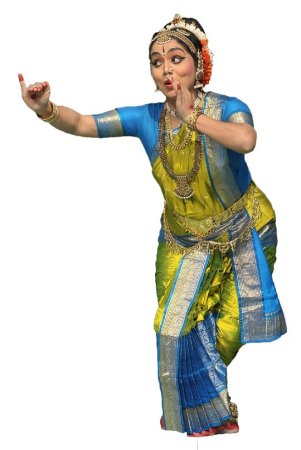 Srimayi Vempati Vempati Chinna Satyam's disciple/daughter-in-law Srimayi Vempati was assigned to present Raudra rasa. In Kuchipudi, generally as per the tradition, male dancers play female roles. Vempati in his dance-dramas often offered male roles to female dancers like Manju Bharggavi. Srimayi selected dance of Shiva from the dance-drama Hara Vilasam, in which when Sati, wife of Shiva, goes uninvited to her father Daksha's Yagna, she is insulted and jumps into the sacrificial fire. Shiva on hearing this arrives and is enraged, performs Tandava and destroys everything. The fury with which he dances makes the universe tremble. Srimayi performed with vigour and energy and did justice to the depiction of Raudra rasa. I saw her for the first time in male role with her aharya of Lord Siva, his locks undone and flying in all directions to the appropriate music to evoke the Raudra rasa. I have seen Vempati's son Ravi Shankar performing this dance in Hara Vilasa. Also much earlier, had the luck to watch Vempati himself perform this number. Srimayi did justice to the rasa assigned. In Q and A, references were made for the reversal of roles by female dancers playing male roles. Rajika often mentioned Hari Vilasam, which was incorrect. It is Hara Vilasam. Hari would mean Krishna, Vishnu. 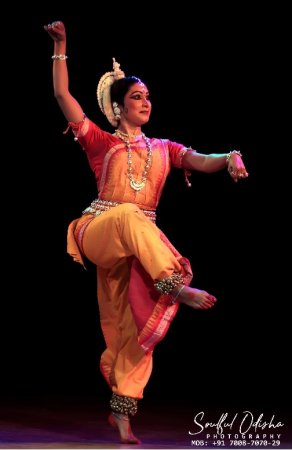 Sujata Mohapatra Sujata Mohapatra, daughter-in-law of Guru Kelucharan Mohapatra, presented Veera rasa in Odissi. She selected from Ramcharitamanas, the prayer Sri Ramachandra kripalu bhajamana, and interpreted the form of Lord Rama as a veera purusha. Another composition was from Ramayana, the sequence of Lord Rama breaking the bow of Lord Shiva to marry Sita. As a regal and mighty person, Rama's characterization was extremely well enacted .The choreography of both the numbers was by Kelubabu's son Ratikant Mohapatra. Sujata is a seasoned dancer representing the best of Guru Kelucharan Mohapatra's style. In Q and A, when asked how she maintains the difference in choreography of Kelubabu and that of Ratikant, she explained that as she is steeped in Kelubabu's style, she performs it naturally remaining faithful to Guru's approach. And for Ratikant's choreography, she equally follows his style which is a continuation of Guruji's style. Rajika mentioned that now their daughter Preetisha is also following their footsteps. 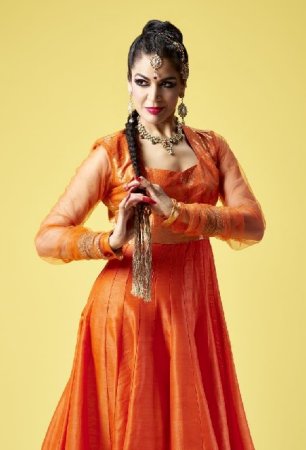 Rachna Nivas From New York, Rachna Nivas, a disciple of Chitresh Das, a doyen of Jaipuri gharana, presented Bibhatsa rasa taking the story of Shurpanaka in Kathak. Chitresh Das's Kathak is energetic and has vigour of Jaipur gharana. Naturally Rachna Nivas's approach was in keeping with her guru's style. Her characterization of each of the character she impersonated was energetic. Taking palta, as in Kathak a dancer takes round to change from one character to another, Rachna succeeded in depicting Rama, Lakshmana with energy and that of Sita with lasya, grace. Transforming herself into a beautiful maiden, as Shurpanaka she adopted graceful movements. The story is well known. When Shurpanaka is rejected by Rama and Lakshmana and is enraged, she takes her former form of demoness, with her arms raised and tongue lolling, running wildly, using footwork imaginatively and rushes out displaying her frightful visage suggesting Bibhatsa rasa, disgust. Kathak admits of lokadharmi aspect which conveys to audience the narrative easily. Rachna used lokadharmi aspect successfully as much as natyadharmi in the end making Shurpanaka's character dramatic. She is doubtless a devotee of Chitresh Das and brings out the essence of his style. In Q and A, Rajika rightly drew attention to Chitresh Das's approach to see common points between Kathak and tap dance and how he used to perform with a celebrated tap dancer. Chitresh Das has left a nice legacy and his innumerable American female disciples are carrying on his legacy admirably.  Anita Sharma From Guwahati, Sattriya dancer Anita Sharma in her three short pieces depicted Adbhuta rasa, wonderment. Disciple of senior Sattriya Guru Jatin Das, Anita had choreographed all three numbers herself. The music was composed by Bhaskara Jyoti Ojha. Anita depicted the story of Puthana being sent by Kamsa to kill Krishna. Her characterization of Puthana was interesting. When Puthana cradles child Krishna to feed from her breasts, Krishna sucks her life out and all cowherd maids are surprised at his deed. In second episode, she dealt with Yashoda asking Krishna to open his mouth as she saw him eating earth, and when Krishna opened his mouth she saw entire universe and realized with amazement that her son was not an ordinary child. The third episode was of Bakasura vadha. When children entered the mouth of Bakasura, Krishna tore open his beak and killed the demon and saved the children. The wonderment, Adbhuta rasa found felicitous expression in Anita's depiction. Besides Bhakti as a predominant rasa in Sattriya, such presentations explore the form and help in removing monotony of Bhakti rasa. A versatile dancer, Anita has contributed a lot in popularizing Sattriya. In Q and A, Rajika drew attention to work of Bhabananda Barbayan and other traditional gurus, who have been visiting America and other countries. Anita acknowledged the historic work by Dr. Bhupen Hazarika who as a chairman of Sangeet Natak Akademi, convened a conference and Sattriya was given status as India's eighth classical dance form. 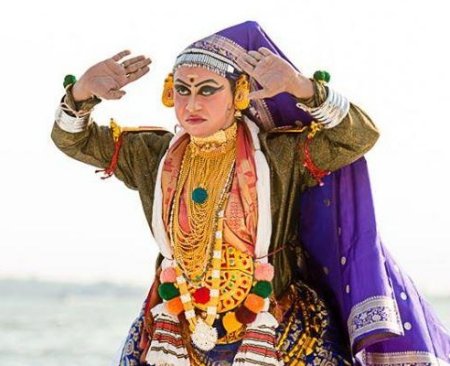 Prabal Gupta The finale was by Kathakali dancer Prabal Gupta, a disciple of asan Sadanam Balakrishnan. Well known for his impersonations of female characters, Prabal had with permission of his guru and getting the text written in Sanskrit, presented character of Lady Macbeth for Bhayanaka rasa. Having instigated her husband Macbeth to kill several rivals, she suffers from fear, and as Shakespeare shows, whenever she washes her hands, the smell of blood tortures her. However hard she tries the smell of blood does not go away and Lady Macbeth is frightened and is overcome by fear. Prabal performed it with great dexterity and excellent facial expressions and through angikabhinaya. The repeated attempts to wash hands and the smell not leaving him were enacted well. However the Shanta rasa did not come through as it should. Finally we see Lady Macbeth falling on her bed. How she achieves peace is not indicated, except that with her falling and perhaps in death she achieves peace. I am not sure if this leads to Shanta rasa. Prabal would do well to re-choreograph that aspect with guidance from his asan. In Q and A by another young lady, Prabal explained how his Guru has attempted Othello play in Kathakali. Therefore such plays can be adapted to Kathakali. But the libretto has to be either in Manipravalam, Malayalam or Sanskrit language to suit the music and the Kerala art form. The entire program with Q and A went overboard and crossed the time limit. That was exhausting. If the organizers are to release it in YouTube, I suggest it be made in two parts, as then audience would be able to take it in, because even during a regular performance in a theatre, beyond one and half hours, the attention of the audience wavers. 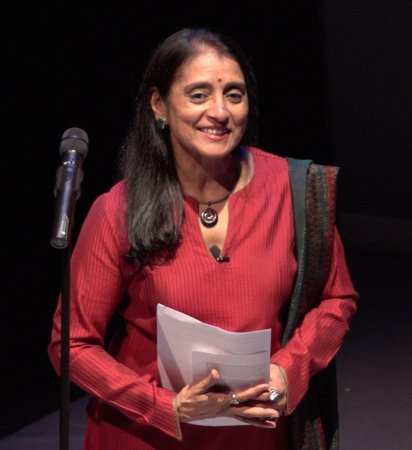 Rajika Puri In changing times, one must admit that this attempt on part of Ajayveer, Prabal, Rajika, and a whole team of technical support deserve congratulations. All the dancers are established and consummate performers. Therefore, the Navarasa theme holds the entire program well. It is a miracle that technology offers such an alternative and audience is able to watch the performances sitting in their drawing rooms in any part of the world.  Dr. Sunil Kothari is a dance historian, scholar, author and critic, Padma Shri awardee and fellow, Sangeet Natak Akademi. Dance Critics' Association, New York, has honoured him with Lifetime Achievement award. Post your comments Please provide your name and email id when you use the Anonymous profile in the blog to post a comment. All appropriate comments posted with name and email id in the blog will also be featured in the site. |